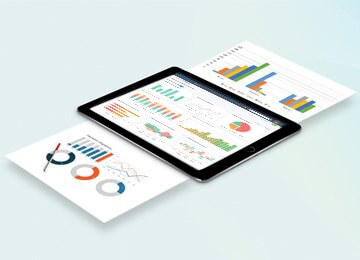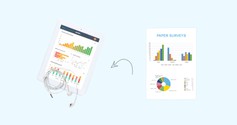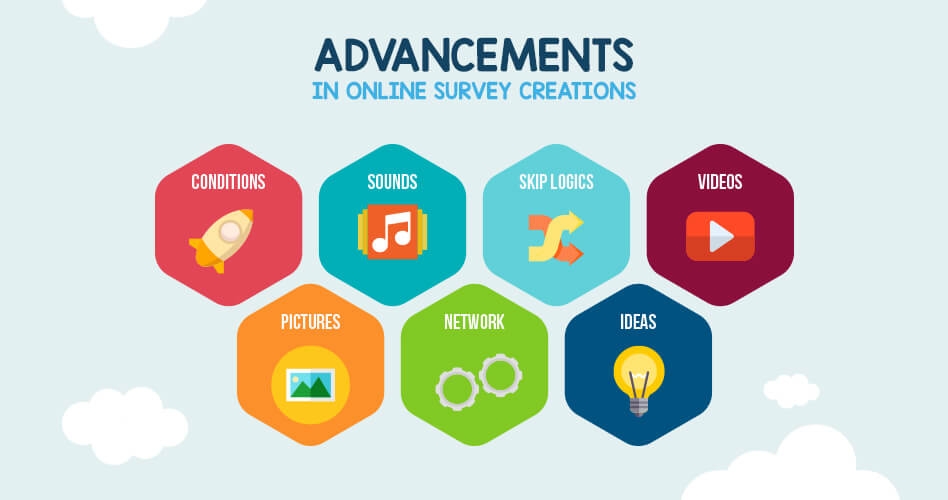The abundance of online survey providers has provided a massive shift from paper based surveys, to digital means of collecting data. What once required printing thousands of paper surveys, can now be achieved through digital distribution. Whether it be through email, a special app or in-person with data recorded on a tablet device, online surveys can be much more convenient to spread around.
There are many reasons why online surveys have become so popular over the past decade, thanks to their accessibility, cost-effective means of collecting data, algorithms for analyzing results and the ability to personalize how your findings are presented. We’ll take a look now at some of the traditional methods used for surveys and see how their online counterparts compare.
Direct mail surveys
Traditionally, paper surveys were distributed either by mail, through the phone or in-person. If you were sending out paper surveys through direct mail, this would require printing out a large amount of copies for your respondents to fill out. This approach can be costly and result in a waste of resources, due to surveys being improperly filled out or not being returned at all. Surveys distributed by mail also require a long waiting period between sending them out and receiving the results, which can take weeks or even months. This doesn’t even cover the expenses related to mailing out the surveys themselves.
In comparison, online surveys do not have these issues, as there’s no need for printing and the response time is generally much faster when distributed through the internet. Using an online survey provider is also cheaper and has no fee for delivering them.
Phone surveys
Paper surveys conducted over the phone suffer from similar problems to direct mail distribution, as the need for printing numerous copies is still there. Phone surveys that record data using paper are also less lenient towards mistakes or changes, since it takes longer to rub out an error than it does to press ‘Backspace’ on a keyboard. Phone surveys that are conducted using software means are far more convenient to navigate through, along with them being easier to make corrections to a respondent’s answers. Typing is also generally faster than writing down too, which is greatly beneficial when filling out long or short answer questions.
In-Person
Having a face-to-face meeting with someone conducting a survey offers a personal touch that hasn’t yet been matched by online methods. However, with the rise of mobile devices such as smart phones and tablets, more and more companies are using online survey providers to optimize the survey process for mobile users. This includes creating an interface that’s easily accessible to respondents and survey conductors, while being able to maintain the ‘human’ element of face-to-face interaction during the process.
This means that more survey results can be recorded through a mobile device and then digitally stored for later analysis, without having to manually assess every respondent’s answers. This brings us to the cost of analyzing data.
Cost of data analysis
The cost of collecting and analyzing all of your information goes deeper than money spent. The time required to manually record each individual findings, then categorizing them into presentable data, is simply an enormous task to undertake. These days, companies don’t want to delegate manual tasks to people, if it can be performed just as well by a computer. This allows survey creators to spend more time on other avenues related to their survey, such as fine tuning problem areas, assessing long and short answer questions and deciding how they wish to present their findings.
Presentation
Online survey providers allow creators to customize the look of their survey, through a choice of colors and themes. If you’re representing a brand, your survey can be tailored to display that brand’s image, or it can be personalized depending on the demographic of your target audience. An online survey service also gives you an array of ways to present questions. This includes implementing a good balance of multiple choice, scaled-based, short and long answer questions, which can be achieved much more quickly than through paper means.
Other criteria’s such as word length, dropdown lists and correct formatting, can also be done quickly through the aid of an online service provider.
Web based surveys and paper surveys: From a respondent’s perspective
With the advent of online survey providers, there has been much research into the psychological effects behind how people respond to different surveys. In 2011, a study was conducted to compare the responses between 4 different methods of survey distribution, which ranged from paper to online services.
The results uncovered that the response rate between digital and paper means of distribution was minimal, with paper surveys only having a 4% difference between their digital counterpart. The slightly lower response rate between paper and digital could be attested to inbox clutter in many consumer email accounts, along with a lack of online accessibility among certain respondents.
In today’s world where information is thrown at us at an increasing rate, the comparable response rate between paper and digitally distributed surveys is very impressive. Studies have also shown that the quality of responses between traditional and online surveys is minimal, thus, providing increasing evidence to support the online approach to survey distribution.
Distribution channels
Understanding your target market and distribution channels remains an important aspect of creating your survey, along with creating an experience that’s accessible to all participants. Through the low-cost approach of digital distribution, online surveys have the potential to reach audiences from almost anywhere around the world. Online surveys can also be easily completed without heavily interfering with a person’s current activities, as it simply requires opening a new tab in their browser and does not need to be mailed back.
Overview
Learning about the differences between paper and online surveys is beneficial in understanding your target audience and why online methods have prevailed over the last decade. As we continue to make more connections over the internet, online survey providers will keep creating new ways for participants to engage with them. Unbound by the limitations of paper, online surveys are continually becoming more advanced with each passing year.








